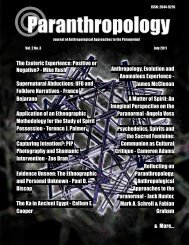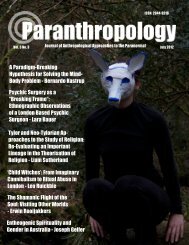Psi and Psychedelics - Paranthropology - Weebly
Psi and Psychedelics - Paranthropology - Weebly
Psi and Psychedelics - Paranthropology - Weebly
Create successful ePaper yourself
Turn your PDF publications into a flip-book with our unique Google optimized e-Paper software.
PARANTHROPOLOGY: JOURNAL OF ANTHROPOLOGICAL APPROACHES TO THE PARANORMAL VOL. 2 NO. 2<br />
beta-carboline called pinoline (6-methoxy<br />
tetrahydro-β-carboline, 6-MeOTHBC).<br />
Pinoline can be formed in the mammalian<br />
body under physiological conditions from<br />
serotonin (5HT) or as a tricyclic<br />
metabolite of melatonin. 20 Mclsaac 21 was<br />
one of the first to demonstrate that<br />
pinoline can be formed in the pineal<br />
under certain specific conditions. This has<br />
been confirmed by several researchers.<br />
For example, Langer et al.22 found that<br />
pinoline was present in the human pineal<br />
gl<strong>and</strong>. They proposed that it might act to<br />
modulate the uptake of serotonin in the<br />
synapses — which links with Strassman’s<br />
<strong>and</strong> Callaway’s ideas concerning<br />
serotonin <strong>and</strong> its possible conversion to<br />
the hallucinogen DMT. They also found<br />
that the pineal contains as much pinoline<br />
as it does melatonin <strong>and</strong> that, at least in<br />
cell culture, 6-methoxyharmalan can be<br />
formed from serotonin. 23 Neurochemical<br />
terminology can be very confusing so it<br />
must be understood clearly that harmaline<br />
<strong>and</strong> the harmala alkaloids are all betacarbolines,<br />
of which there are many<br />
varieties with very similar properties. See<br />
the illustration above which shows three<br />
alkaloids which all look very similar. The<br />
first is found in the pineal gl<strong>and</strong>; the other<br />
two are found in Ayahuasca.<br />
Prozialeck et al24 have observed<br />
the apparent precursor for pinoline to be<br />
located to the greatest extent in the pineal.<br />
They have also shown that THBC <strong>and</strong><br />
pinoline are potent inhibitors of serotonin<br />
neuronal uptake <strong>and</strong> so elevate plasma<br />
<strong>and</strong> brain levels of serotonin. 25 Thus, they<br />
are suggesting that pinoline, which is<br />
found in our brains in the pineal gl<strong>and</strong>,<br />
works by preventing the breakdown of<br />
serotonin. Beta-carbolines are<br />
neuromodulators in the sense of playing<br />
an important role in the fine-tuning of the<br />
actions of neurotransmitters. Their main<br />
action is inhibition of MAO-A<br />
(monoamine oxidase), which breaks<br />
down serotonin <strong>and</strong> noradrenaline. That<br />
is, they prevent the breakdown of these<br />
neurotransmitters <strong>and</strong> so cause a build-up<br />
of them in the synapses. It is this action<br />
that is the chemical concomitant of<br />
hallucinogens. 26<br />
Strassman 27 has suggested that<br />
MAO inhibiters, such as pinoline, could<br />
be involved in converting serotonin into<br />
di-methyl-tryptamine (DMT). This is the<br />
visionary hallucinogen found in certain<br />
ingredients (e.g., Psychotria viridis) of<br />
Ayahuasca. Endogenous biosynthesis of<br />
DMT might also occur through the<br />
conversion of the common amino acid<br />
tryptophan. 28 In other words our pineal<br />
gl<strong>and</strong> makes our own endogenous<br />
Ayahuasca every night of our lives! The<br />
pineal gl<strong>and</strong> is therefore possibly<br />
involved in altering our state of<br />
consciousness to a potentially psiconducive<br />
state.<br />
When harmala alkaloids are taken<br />
orally by humans, at the highest doses<br />
they cause visions, hallucinations,<br />
vomiting, tremor, buzzing in the ears,<br />
cold sweating, dysphoria, <strong>and</strong> a drop in<br />
the heart rate. At lower doses they cause<br />
bradycardia (irregular heart beat),<br />
difficulty in focusing the eyes, tingling,<br />
hypotension, cold extremities <strong>and</strong> lightheadedness.<br />
All of these are physiological<br />
effects caused by MAO inhibition. The<br />
major psychological effect of 6methoxyharmalan<br />
is said to be akin to a<br />
state of inspiration <strong>and</strong> heightened<br />
introspection. There is less effect on the<br />
emotions <strong>and</strong> thought processes than with<br />
LSD, although there is a change in<br />
perception of colours, increased<br />
sensitivity to sound <strong>and</strong> taste, passivity<br />
<strong>and</strong> withdrawal. 29<br />
29 PARANTHROPOLOGY: JOURNAL OF ANTHROPOLOGICAL APPROACHES TO THE PARANORMAL




